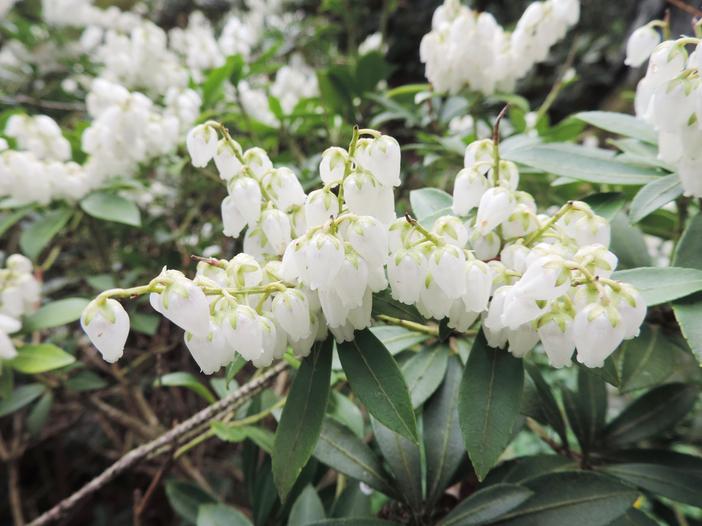Mountain Fetterbush
(Pieris floribunda)
Mountain Fetterbush (Pieris floribunda)
/
/

Krzysztof Ziarnek, Kenraiz
CC BY-SA 4.0
Image By:
Krzysztof Ziarnek, Kenraiz
Recorded By:
Copyright:
CC BY-SA 4.0
Copyright Notice:
Photo by: Krzysztof Ziarnek, Kenraiz | License Type: CC BY-SA 4.0 | License URL: https://creativecommons.org/licenses/by-sa/4.0 | Uploader: Kenraiz | Publisher: Wikipedia Commons































Estimated Native Range
Summary
Pieris floribunda, commonly known as Mountain Fetterbush or Mountain Andromeda, is an evergreen shrub native to the understory of acidic, well-drained woodlands and mountain slopes in the Southeastern United States. It typically grows to a height of 4-6 feet and a width of 3-4 feet. The plant features leathery, dark green leaves and chains of bell-shaped flowers that are typically white, although some may have pink or cream hues. The flowers are quite showy and bloom in late winter to early spring, often attracting pollinators such as bees. After flowering, it may produce small, inconspicuous capsules as fruit.
Mountain Fetterbush is valued for its year-round foliage and its profuse, fragrant flowering which adds interest to the garden in winter and spring. It is often used in residential landscapes for foundation plantings, as a specimen, or in woodland gardens. It requires acidic soil with good drainage and prefers part shade, although it can tolerate full sun in cooler climates. While generally low-maintenance, it can be susceptible to lace bug infestations and root rot if drainage is poor. It is also sensitive to air pollution, making it less suitable for urban environments. There are several cultivars available, such as ’Debutante’ and ’Valley Valentine’, offering variations in flower color and plant size.CC BY-SA 4.0
Mountain Fetterbush is valued for its year-round foliage and its profuse, fragrant flowering which adds interest to the garden in winter and spring. It is often used in residential landscapes for foundation plantings, as a specimen, or in woodland gardens. It requires acidic soil with good drainage and prefers part shade, although it can tolerate full sun in cooler climates. While generally low-maintenance, it can be susceptible to lace bug infestations and root rot if drainage is poor. It is also sensitive to air pollution, making it less suitable for urban environments. There are several cultivars available, such as ’Debutante’ and ’Valley Valentine’, offering variations in flower color and plant size.CC BY-SA 4.0
Plant Description
- Plant Type: Shrub
- Height: 4-6 feet
- Width: 3-4 feet
- Growth Rate: Moderate
- Flower Color: Pink, White, Cream
- Flowering Season: Winter, Spring
- Leaf Retention: Evergreen
Growth Requirements
- Sun: Part Shade
- Water: Medium
- Drainage: Medium, Fast
Common Uses
Bank Stabilization, Bee Garden, Bird Garden, Deer Resistant, Fragrant, Hummingbird Garden, Low Maintenance, Rock Garden
Natural Habitat
Understory of acidic, well-drained woodlands and mountain slopes in the Southeastern United States
Other Names
Common Names: Mountain-Andromeda, Mountain Pieris, Flutterbush, Vielblütige Lavendelheide, Amerikansk Buskrosling, Mountain Andromeda
Scientific Names: , Pieris floribunda, Andromeda floribunda, Andromeda vaccinifolia, Andromeda montana, Zenobia floribunda, Andromeda vacciniifolia, Leucothoe floribunda, Portuna floribunda,
GBIF Accepted Name: Pieris floribunda (Pursh) Benth. ex Hook.